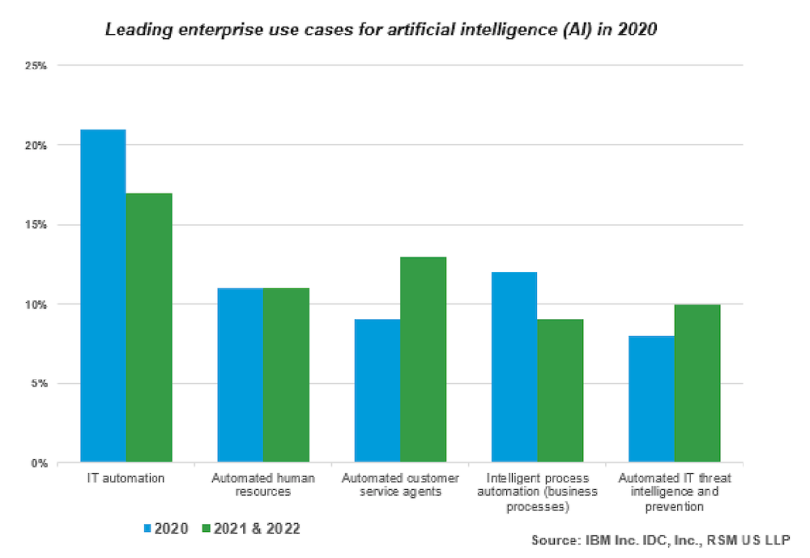Artificial intelligence (AI) and machine learning (ML) are ubiquitous in consumers’ lives, from the “up next” suggestions from your streaming service to routes suggested by your GPS when you plug an address into your phone for directions. Less visible impacts of AI and ML include the use of AI to control data center efficiency and cooling or the management of restaurant wait times, as some companies use AI to make decisions about how many burgers to cook for the day’s lunch rush.
Whereas AI refers to the ability of a computer to emulate human decision-making, ML is the algorithm-driven foundation that enables AI. We can think of automation as the application of AI to develop a series of repeatable tasks or actions designed to accomplish a certain task or execute a process. Companies use automation for transporting products to warehouse workers for packing, processing invoices, and assisting with many other repetitive business tasks that humans have historically performed. Likewise, most people who have worked in an office have probably seen automation show up in the form of the “recognize text” feature in a PDF program.
Although automation isn’t yet as commonplace as AI and ML, current economic conditions could boost its prevalence. With inflation at 9.1 percent in June, labor costs rising, and the Federal Reserve further hiking interest rates, businesses across all sectors need to explore AI, ML, and automation applications as they search for ways to improve speed and efficiency while reducing costs.
What Is the Difference Between Artificial Intelligence and Machine Learning?
What Are the Enterprise Applications of Automation?
Even in ideal economic conditions, companies would still want to explore AI, ML, and automation in their relentless pursuit of greater efficiency. But given the slowing of the economy, these investments will be even more crucial.
Different types of automation fall into three primary groups, according to Gartner: task automation, process automation, and augmentation. Some of the more notable sub-categories include robotic process automation (RPA), business process automation (BPA), conversational AI, natural language processing (NLP), and optical character recognition (OCR).
AI, ML, and automation provide tech-driven solutions to time-consuming business challenges that entry-level workers traditionally handle. These solutions have the potential to reduce execution times drastically, improve accuracy, reduce costs in the long run, and free up employees to add value to their organizations in other ways.
Automation in the areas of IT, human resources, customer service agents, business processes and IT threat intelligence and prevention were the leading enterprise use cases for AI in 2020, according to an International Data Corp. survey published by IBM. Respondents to a separate report from BPTrends that same year indicated that “Almost 75 percent of respondents believe that (business process management) and technologies have helped their organizations accomplish their goals.”

From our perspective, the potential for these technologies to help businesses meet their goals has only grown since 2020. Beyond the five leading enterprise use cases highlighted above, some companies are already looking to mitigate the impacts of the current economic climate by automating expense reports, employee onboarding, purchase orders, work orders, vacation requests and more, as detailed in this article from workflow automation software company Frevvo.
How Will Automation Impact Investments?
Plenty of strong signals indicate that AI, ML, and automation will play an important role in the future of business. Accenture says that, currently, “only 12 percent of enterprise applications are utilizing AI and ML at a maturity level which results in a significant competitive advantage.” At the same time, IDC has estimated that “90 percent of enterprise applications will be supplemented by artificial intelligence and machine learning (AI & ML) by the year 2025.”
The private equity and venture capital deal activity associated with AI, ML, and automation tells a slightly different story from the one of the broader economy’s decline and retraction. In 2021, investors put $249 billion into AI and ML companies globally and $101 billion into workflow automation companies, according to PitchBook data. As of the first quarter of 2022, pre-money valuations were up for all stages of VC investment and median deal value was up for angel, seed, and late-stage companies. IDC predicts the 2023 market size for systems using AI and ML to be just shy of $1 trillion, at $979 billion. Gartner projects the global market for technology that enables automation to reach $596.5 billion by the end of 2022.
Combined, U.S. venture capital (VC) and private equity (PE) firms have almost $1 trillion dollars of dry powder capital. U.S. private equity had $731.4 billion of dry powder as of March 2022, with middle market PE firms accounting for $423.1 billion of that, according to PitchBook. As of June 2022, U.S. venture capital firms had record levels of dry powder at $290 billion, a 23 percent increase from VC dry powder levels at the end of 2021. All to say the private equity and venture firms investing in AI & ML companies have plenty of capital to be allocated.
Adopting AI and ML applications is also becoming less expensive and faster. Technologies that cost more than $1,000 in 2017 cost $7.43 in 2021, and processes that took 372 seconds in 2018 took 47 seconds in 2020, according to Fortune. “Since 2018, the cost to train an image classification system has decreased by 63.6 percent, while training times have improved by 94.4 percent,” according to Stanford. That same report found that lower training costs and faster training times appeared across other parts of a Stanford AI competition.
Especially from an enterprise perspective, it is fortuitous that AI, ML, and their application through automation are getting faster, more user friendly, and less expensive at precisely the same time that labor and borrowing are becoming more expensive. All the while, median deal sizes and valuations for AI, ML and automation companies haven’t taken as hard of a hit as the larger technology sector and U.S. VC and PE firms are sitting on record levels of dry powder. The future of AI, ML, and automation appears to be bright and has a very high ceiling.





